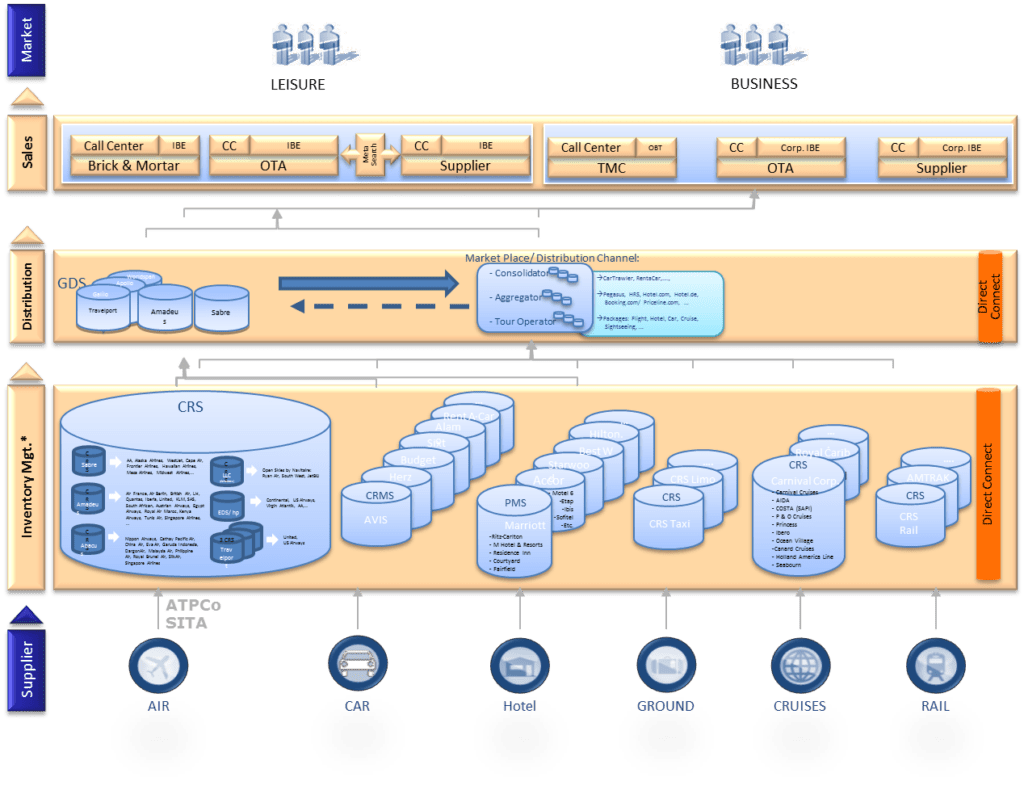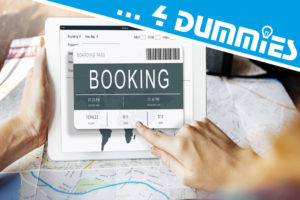The Passenger Service System usually comprises of the Central Reservation System (CRS), in other words booked inventory, an airline inventory system (free inventory) and a departure control system (DCS). It is basically the technology an airline needs:
- The CRS is the system that allows an airline to sell their inventory (seats). It contains information on schedules and fares as well as a database of reservations (or passenger name records) and of issued tickets.
- The airline inventory system may or may not be integrated with the CRS. The system contains all the airline’s flights and the available seats. The main function of the inventory system is to define how many seats are available on a particular flight by opening or closing an individual booking class in accordance with rules defined by the airline.
- The departure control system is the system used by airlines and airports to check in a passenger. The DCS is connected to the reservation system, enabling it to check who has a valid reservation on a flight. The DCS is used to enter information required by customs or border security agencies and to issue the boarding document. In addition, the DCS may also be used to dispatch cargo and to optimize aircraft weight and balance.
If we look at an image from my book Value Creation in Travel Distribution, we can see that a Passenger Service System (PSS) and in this respect the CRS and inventory management portion are part of a central technology piece for airlines:
Travel distribution landscape
- Supplier: airlines, hotels, car rental companies, etc.
- Inventory management: administration of the inventory in a CRS
- Distribution: usually Global Distribution Systems (GDSs), but also aggregators, consolidators and organizers
- Sales: End customers can arrange their travel purchase through the agency/TMC, one of the online agencies (OTA, OTMC) or even the provider directly on the corresponding website (direct).
- Market: the traveler or the company
The Underlying Technology
Still today, PSSs and especially the CRS portion of it are usually built on mainframes running the Transaction Processing Facility (TPF) operating system. However, providers of CRSs are also moving (at least in parts) away from such mainframes to allow for more flexibility, open source and cloud-based solutions (compare The Company Dime [paywall]). Those mainframes along with TPF are often referred to as “antiquated technology” in the travel industry, which may be the case, however, they are very reliable, secure and crazy fast. IBM invented this technology in the 1960s and besides airlines, it is still used by banks, retailers, and insurers – in any field that requires the handling of high volumes of transactions by a large number of users. The operation of such mainframes is expensive though: It is hard to find developers, there is no community of developers providing the services to the public for free and the price for the hardware itself usually has an additional digit. This is the main reason that companies are looking to replace such technology. We have even created automated migration technology to allow (in this case banks, but possible for travel systems as well) to migrate off such expensive technology.
Blog Series: Travel Technology for Dummies
- What Is Full Content?
- What Is a Booking Reference or PNR?
- What Is Overbooking?
- What Is a Passenger Service System (PSS)
- What Are Booking, Waitlists, Tickets, Codeshare & Interlining?
- What Are Active and Passive Segments?
- What Are Incentives, Commissions & Overrides?
- What Is a ‘Married Segment’?
- Blockchain in Travel: All You Need to Know – for Now
- What Is the Difference Between Fares, Rates and Tariffs?
- What Is NDC?
- What Is Continuous Pricing?
- What Is Direct vs. Indirect Distribution?
How to Change a Passenger Service System (PSS)
If airlines change their Passenger Service System (PSS), it is usually a huge undertaking of several years: Southwest, for instance, operated for the better part of 45 years with clumpy technology systems, mainly built in-house. It was generally a cheaper approach that better fit the needs of its network, radically different from those of hub-and-spoke airlines. However, it was lacking crucial flexibility and Southwest could e.g. not follow the general trend of charging for bags, as their system couldn’t be modified to allow ancillary services (did not prevent them from starting a marketing campaign around that for their advantage “bags fly for free”).
In a three years project for $ ½ million dollar, in 2015 Southwest decided to move to a special version of Amadeus’s Altea system as their PSS. Operations schedule to start in the first half of 2017, followed by additional enhancements later that year. New capabilities include: red-eye flying, which Southwest negotiated with its pilots in June 2012 but they haven’t been able to take advantage of these overnight flights to the East Coast and Midwest. Less-than-daily service, so that Southwest does not have to fly the same schedule Sunday-Friday to all the cities in its domestic network any longer, with a separate schedule only on Saturdays. Day-of-the-week tweaks, so that Southwest will be better able to adjust for Tuesday or Wednesday, when airlines tend to suffer from leaner demand. It will also put an end to the old information-technology plumbing, which did not adequately support the airline’s commercial efforts, such as selling early boarding or innovating around other ancillary revenue products.
In the merger of American Airlines and US Airways, the combined airlines switched to Sabre, which was a blow for HP as the old bankrupt American decided for one of the two systems currently supported by HP: AXRes (the former Attraxis system based on old Swissair PARS-based system) and the SHARES multi–host system. However, during chapter 11 proceedings the new American decided for SabreSonic.
Passenger Service System (PSS) changes can be disastrous or successful. United and Continental, combined in 2012, was considered an epic fail. American and US Airways are generally considered a huge success. Regardless, years of planning and preparation have to be taken into consideration.
But due to the fact that it is such a huge undertaking and risk to switch to a new Passenger Service System, it can be considered that providing the PSS to an airline is pretty much the license to print money. In the recent battle between airlines such as Lufthansa and GDSs, which are in most cases also the providers of the PSS, it remains to be seen if airlines can at all set themselves free or are locked into.
List of PSS providers
| Name | Vendor |
|---|---|
| AirCore | Unisys |
| Radixx International | Radixx |
| ACCELaero | Information Systems Associates FZE |
| Altéa | Amadeus |
| Crane PAX | Hitit |
| Zenith | Travel Technology Interactive |
| Open Skies / New Skies | Navitaire (acquired by Amadeus) |
| HP Agilaire / HP Shares (former EDS Shares) | HP |
| SabreSonic | Sabre |
| Horizon | SITA |
| ARCO | Alitalia |
| Travelport Meridian | Travelport |
| RESIBER | Iberia |
| Astral | Aer Lingus |
| Mercator (MARS) | Mercator (Emirates Airlines) |
| AeroCRS | Enoya-one LTD |
Picture credit: Shutterstock / vlad09






This Post Has 27 Comments
Very helpful, thanks!
I’m afraid, I can’t answer this. We are a technology provider and not a content provider. Also this blog is focused on technology. Pricing is solely up to the suppliers (airlines, etc. ).
Hi Michael, if an airline needs to make a change in their PSS, let’s say seat cofiguration of an airplane, how much money that would cost?
Thank you for your nice words .. this keeps me going!
Thank you!
Fully Fantastic Post. Your all post was always been great, Lots of thanks for sharing the best and useful information. Thanks again!
Nice post keep sharing such a wonderful post
[…] Airline inventory is held in the Central Reservation System – CRS (which is today part of the Passenger Service System – PSS) and in the old days was made available by the Global Distribution Systems (GDSs) to agents via […]
[…] parity agreements is now trapped between the claws of two GDSs: Sabre NDC on the API side and Amadeus Altea on the CRS side. Lufthansa, however, kept calm by saying they already have backup players (i.e. […]
Dear Vineet,
1. I’m sorry, Vineet, but this blog is intended to introduce people to travel distribution. Not to go too deep into it and replace documentation provided by IATA, GDSs and all the other players. Again, the diagram that comes closest is https://t.co/n3Y8O8vbKz (more elaborated in my book). E-Retail is a platform for the airline.com website. Airline.com sales are direct distribution and a GDS is not in between (shown in my picture above with that pipe on the right that goes through the distribution layer. Only offers for the indirect sales channels are created by the GDSs. Website offers are usually not created by the GDSs. Many airlines use e.g. ITA software (now Google) as a shopping engine, but there are others, too.
2. + 3. Everybody will come out with Representational State Transfer (REST) interfaces coupled with JSON (JavaScript Object Notation), which are modern API practices that provide flexible and developer-friendly access to back-end resources. We are also debating it on a regular basis. XML is a language from around the year 2000. Developer today ‘run away’ when they hear XML (they probably rather stick around when they hear EDIFACT because they probably don’t know what it is as they were not even born when it came out. EDIFACT is a language still present in travel technology and just now being replaced with NDC). Coming back to REST interface: it is not so easy, because travel is fairly complicated. Especially with business travel lots of functionality is needed and while REST may be easy to be used on the UI (user interface), you still need the flexibility and compile a lot of functionality in the background to create for instance a corporation compliant PNR (or its newer version one order: https://www.travel-industry-blog.com/travel-technology/pnr/). To make it easier for UI developers, the API business logic needs to become more complicated in order to combine the front end with the backend. One large message (XML) has to be broken down in many small messages (Compare our FareSearch: https://xx1.pass-consulting.com/fileadmin/media/1.7.3/documentation/xsd/FareSearchRS_xsd/FareSearchRS.htm , or even worse the air shopping message from IATA NDC). So, somebody has to apply the logic from a few big messages to many small messages. GDS REST interfaces today are usually a ‘sandbox’ environment and their functionalities are limited – probably sufficient for leisure travel, most likely not for business travel. We are working on our iXX1 (https://www.pass-consulting.com/en/industries/travel/) which at some point should become a REST interface. It is supposed to speak traditional legacy backend language but modern front-end language. It is a transitional phase currently from XML to REST. How long it will take, I don’t know. However, it was one of my comment to IATA, that they are replacing 40-year-old technology (EDIFACT) with almost 20-year-old technology (XML) and call it “New” Distribution Capabilities.
4. + 5. Pls. compare https://www.travel-industry-blog.com/travel-technology/fares-rates-and-tariffs/ and stay tuned for my next NDC article (NDC the next curtain)
Thanks,
Michael
Thanks Michael. Your comments were really very helpful and made me think a bit. Have following queries based on how I understood your reply:
1. Is there a Business Context Diagram (BCD; fuctional areas solved by them) for PSS vs. e-Retail vs. GDS? As you mentioned in #5, offer creation is by GDS (prior to NDC), how can e-Retail than use it if GDS will sit in parallel to e-Reatil?
2. Specifically for Amadeus, they have come up with Digital APIs (https://amadeus.com/en/insights/press-release/finnair-transforms-its-booking-experience-with-amadeus-newest-digital-retailing-api) how will it impact the airline industry?
3. The Digital APIs are a wrapper to e-retail solution or PSS? How does it impact NDC? Can Digital APIs be used as NDC? Is it a wise area to start leverage Digutal APIs?
4. Could you please point me where I can read more about what is offer, Offer creation process, their delivery, who all are involved in the process? In case GDS is not there, which system will do it?
5. Also why NDC requires to re-think of Offer and Order Management? What does it really mean? If possible, process flow of creation/management of what we get to see on Airline site?
Thanks so much again and its been always a great learning going through your articles.
Dear Vineet,
Sorry for the delay.
1. PSS/CRS and GDS are two completely different systems. The article mentions what a PSS consists of: one portion is the central reservation system of one (1) airline. Obviously the similar/same software is used for another airline as well, but if you access the CRS of e.g. Lufthansa, you only see Lufthansa (maybe the whole Lufthansa Group). The system is also tailored to hold the inventory of that airline. It does not per se include fares for instance. A GDS accesses many CRSs for availability (up to 500 airlines are listed within the various GDSs). GDS also access other 3rd parties (such as ATPCo) for schedule and faring information. GDSs also usually have a shopping engine (such as Sabre Bargain Finder Max or Amadeus Masterpricer) but there are also other pricing engines such as SITA. GDSs also cache CRS data to ensure that not every of the (in consumer space 500:1) shopping requests hit the reservation system – you realize that when you get the message once you hit book like ‘the fare is no longer available’ or ‘the price has changed’ – which only means the cache of the GDS was outdated. Usually the provider of the PSS also hosts the system, so indeed it is usually a SaaS model. Pls. also take a look here: https://t.co/n3Y8O8vbKz
2.GDSs bring a huge sales channel. Besides direct sales (= own website) a GDS provided indirect sales. If you are listed in a GDS, an airline is in front of many agents and other UIs and the airline will sell significantly more seats. In the litigation of US Air vs. Sabre, this was a major aspect, that Sabre delisted US Air for some time which damaged US Air significantly. A good article for you may be this one: https://www.travel-industry-blog.com/gds/multi-source-booking-tool-costs-and-restrictions/
3. Amadeus e-Retail is another platform from Amadeus which is widely used as a booking system for airlines websites (= direct sales). I believe it powers 260 airline websites for 100 airlines. It is basically to be seen in parallel to the GDSs: A booking through Amadeus e-Retail will go directly to Altea not through the GDS.
4. No, to my knowledge Skyscanner is not an authorized GDS developer (like us). Skyscanner goes directly into the airline systems – however to my knowledge not directly into the CRS system but rather to the newly designed APIs of an airline powered by IATA’s NDC (https://www.travel-industry-blog.com/travel-industry/ndc/). So, I would see Skyscanner rather as an aggregator/Metesearch engine. In my book I touched on Metasearch Engines (Kayak, etc.),.
5. It will not use the EDIFACT pipe. It’s the GDSs decisions if the GDS wants to use NDC. The airline only provides an API and is in control of creating the offer – while historically in a GDS world, the GDSs created the offer based on schedule, fare and availability.
6. Unfortunately, the comment section does not allow me to provide diagrams, but I hope I was able to answer some of your question. My book could also help: http://www.amazon.com/author/strauss. There will be a follow up on NDC shortly. Stay tuned.
Thanks,
Michael